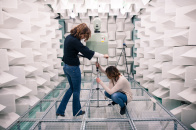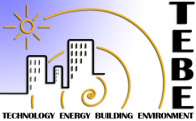Research Project TEBE
TEBE - Technology Energy Building and Environment
The TEBE Research Group, founded by prof. Marco Filippi in 1994, is currently organized in 5 research Units and composed by 10 permanent members (full, associate and assistant professors) and about 25 collaborators (PhD students and Grant Researchers). The Research activities are mainly carried out in in the field of building physics and are related to building energy performance, building envelope technologies and HVAC systems, indoor environmental quality and indoor environmental control (in cultural heritage buildings as well), green buildings integrative design, applied acoustics and lighting.
| Logo |
|
| Coordinator |
|
| Permanent Staff |
|
| Not permanent Staff |
Verena Marie BARTHELMES Elena BO Tiziana BUSO Giulia CALOSSO Ylenia CASCONE Doriana DAL PALU’
Chiara DELMASTRO Domenico DIRUTUGLIANO Stefano FANTUCCI Maria FERRARA Georgios KAZAS Luigi GIOVANNINI Alice LORENZATI Carlotta MATTA Giovanni MURANO Giuseppina Emma PUGLISI Michela RADIS Michela ROTA Gianluca SERALE Ilaria BALLARINI Cristina BECCHIO Silvia CAMMARANO Valentina FABI Alice GORRINO Simona Angela Alina PADUOS Elisa SIROMBO Louena SHTREPI |
| Activity description |
Applied acoustics The research activity is mainly in the framework of architectural and building acoustics. The common thread is the acoustic comfort indoor in everyday life, at home, at the workplace, in the environments for leisure and recreation and in the means of transport. Laboratory and in-field measurements, simulations, administration of questionnaires and listening tests characterize the work methodology in this field of research. Lighting The research activity in the lighting sector is concerned with three macro lines: lighting as key factor to determine the performance and well-being of people; lighting systems and energy demand for a building; lighting for the cultural heritage (light pollution and conservation of materials). These topics are investigated in relation to both indoor and outdoor spaces, through an analysis scale ranging from the component to the room scale, from the building to a district and urban scale. The topic ‘light and people’ also includes the study of the non-visual effects of the spectral emission of light sources, while as for the topic of the energy demand for a building a particular attention is paid to lighting controls, from the viewpoint of achieving smart building and a smart cities. Building Energy Performance The research activity in the building energy performance sector is concerned with various macro lines that affect both the building and the urban scale. They mainly pertain to the use of dynamic energy simulation as instrument for the evaluation of different design solutions, the utilization of simplified methods according with the Standards for buildings energy performance assessment, the exploitation of cost-optimal methodology as design tool for building energy efficiency, the identification of best practices towards nearly-Zero Energy Buildings realization in both new constructions and existing buildings sphere, the building energy management, the energy use optimization in cities (smart cities), the energy modeling for carbon reduction in urban planning. Building Envelope Performances The research activity related to the building envelope is mainly focused on three topics: concept of novel multifunctional façades, characterized by a responsive and adaptive behavior; assessment methods, numerical modeling and experimental analyses (in field and in lab measurements) of both conventional and advanced building envelope materials/components/systems (i.e. Phase Change Materials embedded in glazing and opaque layers, green roofs and green walls, superinsulation materials, as aerogel and VIPs, dynamic insulation systems, shading devices, switchable glazing as thermochromics and thermotropics, active façades integrated with HVAC systems as double skin, climate and hybrid façades); building stock characterization, benchmarking and energy refurbishment tracking. HVAC Systems Heating Ventilation and Air Conditioning systems (HVAC) and their integration in building components are investigated by means of numerical and experimental analyses (e.g. active and dynamic façades integrating Renewable Energy Sources (RES)). Requirements and characteristics of the HVAC are studied considering both common (e.g. office, residential) and special (e.g. yacht, museum, data centres) final uses. The modelling and optimization of multi-source multi-product systems in buildings is carried out. The research is also oriented to the performance assessment of small scale integrated systems for HVAC and DHW production of Zero Energy Buildings. Low temperature heating and high temperature cooling HVAC systems are examined with the aim of improving the performance by reducing temperature differences in heat transfer and energy transport process. In particular, the adoption of slurry Phase Change Materials (PCM) as carrier fluid and storage media is investigated to assess the benefits achievable from exploiting low temperature latent heat storage. The thermal energy storage and the demand side management is studied from the building to the district scale. Furthermore, HVAC are studied also during their operation. In particular, fault detection and diagnosis techniques are adopted for analyzing data gathered from long term monitoring, with the aim to find anomalous consumption patterns or to assess the thermal management (e.g. in data centers). Indoor Environmental Quality The research activity is mainly devoted to the development of methods to measure the performance of buildings in terms of occupant comfort and productivity, energy efficiency and operations. Monitoring the indoor environment has two main goals: to certificate the IEQ, according to the international standards on comfort, and use the monitored data as input for building and systems diagnostic. However maintaining a high level of comfort is often related to significant energy costs. In this framework, the investigations are also aimed at finding a balance between comfort and costs and at assessing the impact of occupants action and behavior to improve the IEQ conditions on the final energy use. Indoor Environmental Control The research activity is devoted to numerical and experimental activities related to the environmental control of small scale and large scale enclosures of various types such as the ones for the preservation of works of art, passengers compartments of vehicles, ships and aeronautical and space vehicles, animal housing and greenhouses. Some specific topics currently under investigation are the relationship between environmental variables and degradation processes of works of art; performance and optimization of HVAC and lighting systems in museums, archives and libraries; indoor environmental control vs. energy use in livestock buildings and greenhouses. Green Buildings Integrative Design A cost effective design of green buildings requires a deep process of optimization in order to meet all the sustainability goals in the field of energy, indoor environmental quality, water management, sustainable materials within a pre-defined budget. Through an integrative design approach, the research focuses on methodology development for the optimization of the building components which affect energy demand and indoor comfort conditions, from the concept design stage to the final. The holistic approach requires the use of dynamic simulation methods and sustainability assessment tools to evaluate performances and conduct sensitivity analysis of different design configurations. |
| Labs |
The Research Group has set up some facilities for lab measurements and has a range of sensors and systems for specific in-field measurements. The main facilities are: - For the energy performance assessment, 2 Outdoor Test Cells - (TWINS -Testing Window INnovative Systems), a climatic chamber and a heat flow meter (Lasercomp Fox 600) (contact person Marco Perino) - For acoustic analyses, an anechoic chamber (contact person Arianna Astolfi) - For daylighting analyses, an artificial sky (contact person Chiara Aghemo) The Research Group is moreover the scientific referent of LAMSA - Analyses and Modeling of Environmental Systems Laboratory. |
| Partnerships |
The Research Group has established over the years a strong relationship with the main research centers both at national and international level and have earnt international recognition in the field of Building Physics |
| Website |
|
| ERC Group sector |
PE8 Products and processes engineering - PE8_3 Civil engineering, architecture, maritime/hydraulic engineering, geotechnics, waste treatment PE8 Products and processes engineering - PE8_6 Energy systems (production, distribution, application) PE8 Products and processes engineering - PE8_11 Product design, ergonomics, man-machine interfaces PE8 Products and processes engineering - PE8_12 Lightweight construction, textile technology |



 Web site
Web site